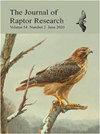THE ROLE OF FOOD QUANTITY AND PREY TYPE IN NESTLING DEVELOPMENT OF AMERICAN KESTRELS
IF 1.2
4区 生物学
Q2 ORNITHOLOGY
引用次数: 1
Abstract
Diet is an important component of life history that can vary with, and ultimately determine, individual variation in phenotypically plastic traits. American Kestrels (Falco sparverius) generally have low post-fledging survival rates, which suggests a need to better understand what ecological factors, such as diet, influence nestling maturity. The generalist diet of kestrels makes it unlikely that all nestlings in a population receive the same diet. We investigated how breeding phenology and nestling sex ratio interact with diet metrics (diet diversity, percentage of prey types, rate of prey biomass delivery) and relate to nestling maturity (mass, tarsus length, wing length, hematocrit, hemoglobin concentration). We hypothesized that: (1) phenology and nestling sex ratio would correlate with inter-nest diet variation; (2) diet metrics would be predictive of nestling development; and (3) the manipulation of food quantity through food supplementation would lead to nestlings with greater developmental maturity. We found that inter-nest variation in diet was correlated with breeding phenology and nestling sex ratio, independently. However, the variation in diet was unrelated to nestling maturity. In response to food supplementation, kestrel parents decreased their food-provisioning rate, indicating that food quantity regulates parental care. Male nestlings appeared to benefit from supplementation while females did not. Our data demonstrated high inter-brood variation in nestling diet, and suggested that diet variation interacts with sex to influence growth and development of nestlings, which could potentially be linked to population decline.食物量和猎物类型在美洲红隼雏鸟发育中的作用
饮食是生命史的一个重要组成部分,它可以随表型可塑性特征的个体差异而变化,并最终决定个体差异。美国红隼(Falco sparverius)的雏鸟成活率通常较低,这表明需要更好地了解生态因素,如饮食,影响雏鸟的成熟。红隼的通用性饮食使得一个种群中的所有雏鸟都不可能得到相同的饮食。我们研究了繁殖物候和雏鸟性别比如何与饮食指标(饮食多样性、猎物类型百分比、猎物生物量交付率)和雏鸟成熟度(质量、跗骨长度、翅膀长度、红细胞压积、血红蛋白浓度)相互作用。我们假设:(1)物候和雏鸟性别比与巢间食性变化相关;(2)饮食指标可预测雏鸟发育;(3)通过补充食物来控制食物量,可以使雏鸟发育成熟。结果表明,巢间食性变化与繁殖物候和雏鸟性别比独立相关。然而,饮食的变化与雏鸟成熟度无关。红隼父母对食物补充的反应降低了食物供给率,表明食物数量调节了亲代抚育。雄性雏鸟似乎从补充中受益,而雌性雏鸟则没有。我们的数据表明,雏鸟的饮食在雏鸟之间存在很大的差异,并表明饮食差异与性别相互作用,影响雏鸟的生长发育,这可能与种群数量下降有关。
本文章由计算机程序翻译,如有差异,请以英文原文为准。
求助全文
约1分钟内获得全文
求助全文
来源期刊

Journal of Raptor Research
生物-鸟类学
CiteScore
2.30
自引率
17.60%
发文量
61
审稿时长
>12 weeks
期刊介绍:
The Journal of Raptor Research (JRR) is an international scientific journal dedicated entirely to the dissemination of information about birds of prey. Established in 1967, JRR has published peer-reviewed research on raptor ecology, behavior, life history, conservation, and techniques. JRR is available quarterly to members in electronic and paper format.
 求助内容:
求助内容: 应助结果提醒方式:
应助结果提醒方式:


